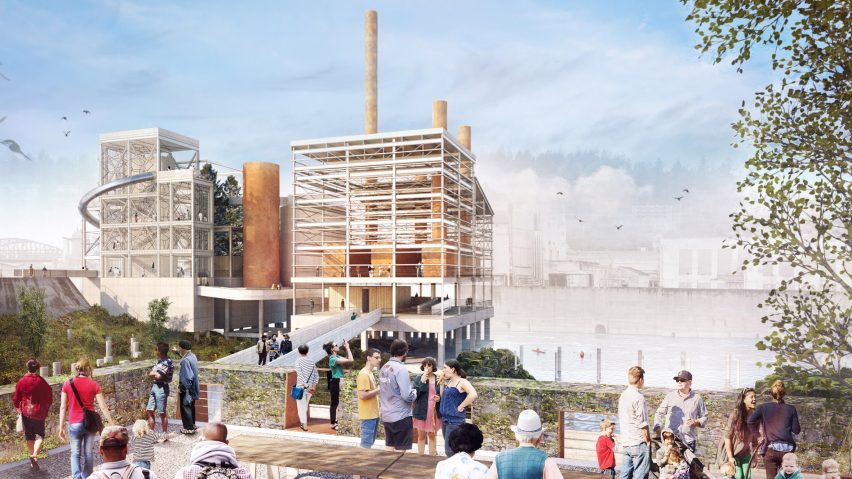Snøhetta has unveiled its plans to transform an abandoned paper mill blocking a view of Oregon City's Willamette Falls and waterfront into a cultural complex looped by an elevated pathway.
Located on the Willamette River, The Riverwalk will open up views of Willamette Falls – North America's second largest waterfall in volume – that haven't been accessible for 150 years.
As well as reconnecting Oregon City to its waterfront and fall views, the restoration of the site between the city and West Linn will also restore the historic basalt topography and aid ecological habitats.
To achieve this, Snøhetta will repurpose the former Blue Heron paper mill site. Parts of the industrial buildings will be restored and others demolished to create a series of public spaces, including a visitor's centre, a public hall, a theatre and a conifer grove.
An elevated trail set on existing structures will weave across the 27-acre site, starting in Oregon City's historic downtown and ending at the crest of the falls. It will feature three main lookout points on the way.
The site will be divided into four sections. In the first, The North Riverfront Area, the firms plans to remove existing structures to expose ancient basalt on which the 1980s Flour Mill is set.
Leading around the exposed basalt, the pathway will loop through the Flour Mill to offer views of the machinery and end at an old retaining wall on the water's edge – one of the main viewing platforms.
In the next section, the promenade will thread between the old woollen mill, which will be stripped back inside to create a large public hall. Its extension named Mill O is to be transformed into the industrial site's visitor's centre.
Both buildings will spill out onto the new public yard, where the historic wooden carpentry shop will be restored to host public performances.
At the water's edge, the walls of a vertical structure will be removed to create a porch-like promenade linked with the main trail.
A long stretch of steps will be carved down towards the southern edge of the site by the dam. Here, concrete structures will be removed to open up an alcove for migrating fish to seek refuge.
In the third stage, a huge boiler will be restored to showcase machinery and a "cathedral-like" interior, while the corrugated cladding of the mill will be stripped away to reveal its steel and concrete skeleton.
Named Mill H, this structure will host a children's play tower and two look-out points to the falls. Its concrete foundations will be repurposed and filled with a large volume of soil to grow conifer trees.
Guiding from here, the path will encircle a clarifier. Once used to treat water, it will be landscaped to offer an outdoor space for picnics.
In this area, paths will be raised well above the ground to emphasise the height of the falls. It will end on the southern side at the final falls lookout – the Hawley Powerhouse Foundation – which will provide a 360-degree view at the centre of the river and the falls.
Structures in the Riverwalk, which is slated to begin construction in 2018, are designed to withstand flooding and earthquakes.
Snøhetta, which has offices in Oslo and New York, ranked at number 37 in the inaugural Dezeen Hot List.
The firm recently teamed up with Harvard University and Skanska Technology to retrofit an old house, as an example of making existing buildings more energy efficient to help address climate change.
Its other recent projects include a shipping tunnel on Norway's coast, pared-back offices for Slack in Lower Manhattan and a memorial arch for South African anti-apartheid activist Desmond Tutu.

